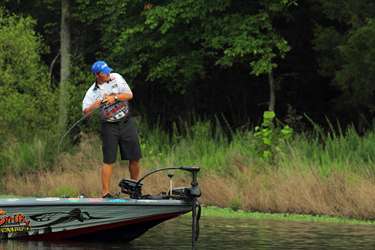
Lacking the benefits of air conditioning, sunscreen or ceiling fans, bass endure summer’s swelter by utilizing their two main temperature modification tools — depth and cover. Habitat determines which option they use, as lakes with offshore grass such as hydrilla, coontail and milfoil, or peppergrass extending from shorelines, present the attractive combination of shady comfort and feeding opportunities.
From Toledo Bend’s southern half, to the Potomac’s Mount Vernon area, to Lake Champlain’s Ticonderoga region, areas dominated by grass will hold fish throughout the summer months, but just where you find your quarry depends on a few key factors.
Bass are always most active in the early mornings and late afternoon, so look for fish roaming the edges during these cooler periods. Overcast or rainy days will extend the cooler hours, so the bass may spend more time chasing bait along the grass perimeters. In tidal environments like the California Delta, Louisiana’s Atchafalaya Basin and the Potomac, rising water opens the door for fish to move under and into the grass, while falling tides compress the vegetation and squeeze fish toward the outer edges.
Whenever bass run the grass edges, crankbaits can be very effective for locating productive areas that you may want to pick apart with plastics. Two options here: Probe the perimeter with various size cranks to identify the depth at which the fish are working, or try the grip-and-rip tactic to tempt bass holding right at the edge. For the latter, throw perpendicular to the grass edge, crank down until you make light contact and then rip the bait out of the vegetation to simulate a crawfish flipping from one stalk to the next.
Other productive summer grass tactics include:
Punching
Driving heavily weighted plastics such as Reaction Innovations Sweet Beavers, Strike King Rodents or even a 10-inch ribbontail worm through hydrilla mats is a good way to trigger reaction bites from napping bass. There’s no finesse here, so don’t skimp on the sinkers. Use tungsten bullet weights of 1 to 1 1/2 ounce or you’ll risk hanging in the dense cover and ruining the element of surprise.
Flipping/Pitching
With coontail and milfoil growing mostly in clumps that are generally solid to the bottom, there’s no canopy, just gaps in the cover. Jigs and Texas rigged plastics are effective here. Strikes will come quickly, so don’t waste a lot of time prospecting any one hole. Just drop the bait, give it a wiggle and, if no one’s home, keep moving.
Spinnerbaits
The flash of gold and silver willow blades will catch the eye of anything roaming a grass edge in search of baitfish, but once the fish tuck inside the grass, you may need the heavier thump of a Colorado blade to get their attention.
Frogs/Toads
The realistic kicking action of a buzz toad (Zoom Horny Toad, Stanley Ribbit, Gambler Cane Toad) works wonders when gurgled over and through scattered vegetation. Aim for the gaps or “windows” where bass have a clear lane of attack. Hollow body frogs (Spro Bronze Eye, Snag Proof’s Chris Lane Guntersville Frog, Koppers Live Target Hollow Body Frog) also deliver the crazy stuff when dragged across matted hydrilla or peppergrass leafage. A frog’s buoyancy offers the strategic advantage of pausing over the windows to give bass a good look and more time to make up their minds.
Topwater Plugs
Walking a Zara Spook or Lucky Craft Sammy along the edges of a hydrilla wall or the outer boundary of peppergrass will often push the residents over the edge. Wakebaits like Lucky Craft’s Fat CB, Rapala’s DT Fat and Mann’s Baby Waker increase the surface display and crank up the vibrations to entice reticent bass. A waker’s relatively straight course does well within fields of scattered vegetation where a traditional topwater’s side-to-side action risks snagging. You don’t need much space — sometimes a 10- to 20-foot lane between clumps provides enough window for a bass to spot and attack the target.
A couple of summer grass strategy points
First, stay alert for baitfish activity. Forage species may not have any predators on their tail when you spot them, but if their sound or movement attracts your attention, it won’t go unnoticed below.
Watch other boats and note how/where they may be unwittingly corralling the fish. Let too many vessels plow into a big grass mat to flip what is perceived to be the center sweet spot and a lot of the fish will slide out toward the edges. Give the situation time to develop and work the perimeter zone.
Originally published July 2010





